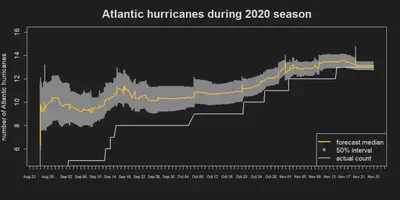AGORA hurricane prediction markets settled

On November 30 the 2020 Atlantic hurricane season came to an end and Hivemind settled prediction markets forecasting how many hurricanes there would be and how many would make landfall over the U.S.
The 2020 hurricane season was one of the most active ever seen. There were 30 named storms, beating the 2005 record of 28. Of the 30 storms, 13 achieved hurricane strength and 6 of those made landfall over the U.S., with a further 4 making landfall over Central America.
As part of its participation in the Fifth Cohort of the Lloyd’s Lab InsurTech accelerator, Hivemind ran hurricane prediction markets on its AGORA prediction market platform. Twenty experts in meteorology and statistical climatology from academia and the private sector took part. The market opened in August when the season was underway and three hurricanes had already occurred. Forecasts from groups at Colorado State University and Tropical Storm Risk were for an active season with 12 and 10 hurricanes respectively. This information was immediately priced into the market, with the expected number of hurricanes jumping from the climatological average of 6 to around 10 on opening.
As the season progressed the market expectation fluctuated in response to the formation of new storms — increasing to 12 when three hurricanes formed in the space of a week and falling back during a two week period with no hurricanes. It rose again as a succession of storms formed that meant, as in 2005, the National Hurricane Centre exhausted their alphabetized storm names and had to resort to Greek letters.
Hailiang Du, Assistant Professor of Statistics at Durham University, finished top in the market for the total number of hurricanes. “I usually looked at NOAA 5-day and 2-day outlooks, sometimes also European model runs as well as Canadian models,” explained Professor Du, “I tried to aggregate the model information together to form my own forecast probability distribution.”
The AGORA hurricane prediction markets demonstrate how prediction markets assimilate new information as it becomes available. Unlike surveys, which provide a snapshot of views at a point in time, prediction markets allow participants to update their positions in real time.
AGORA prediction markets could be used to generate pre-season forecasts of hurricane activity. Markets for multiple years ahead could also produce consensus predictions of the impact climate change may have on storm frequencies and intensities.
The original version of this article appeared as AGORA hurricane prediction markets settled.